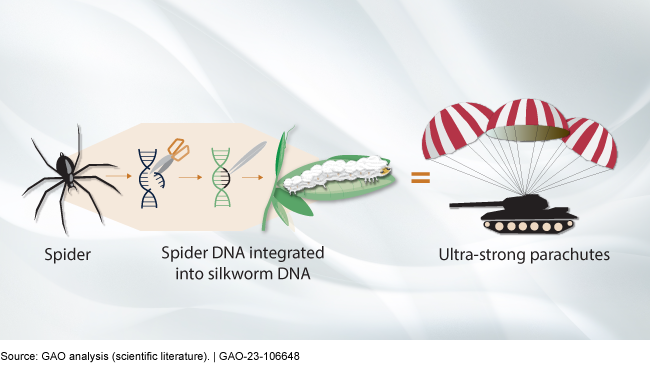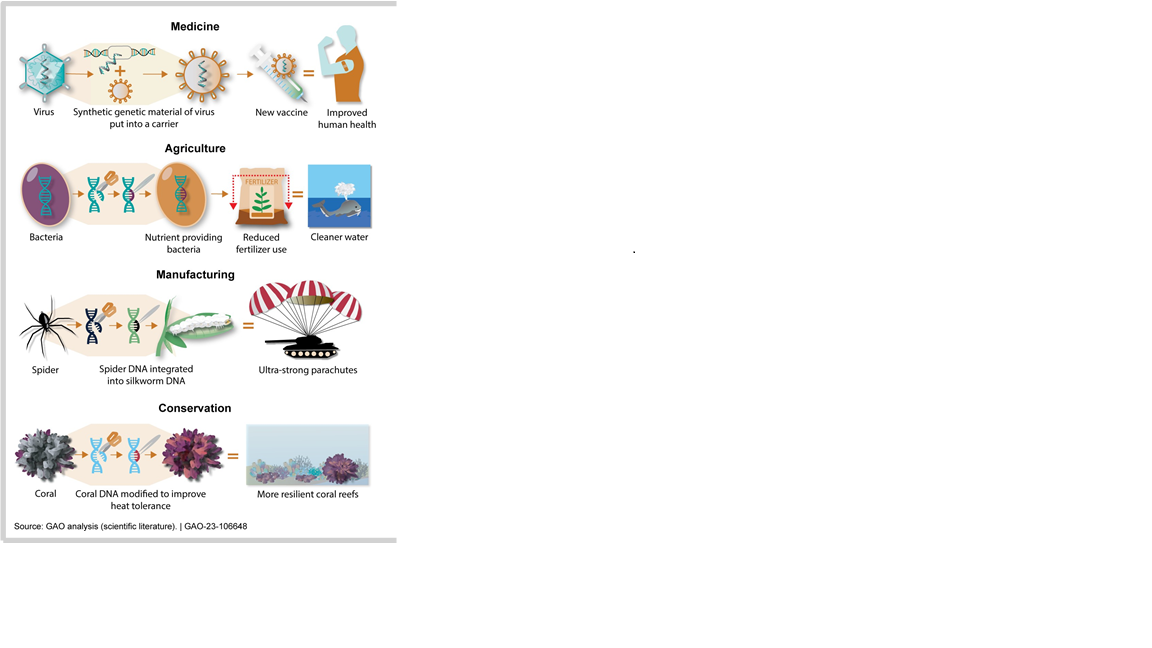Science & Tech Spotlight: Synthetic Biology
Fast Facts
Synthetic biology can change the genetic material in viruses, bacteria, yeasts, plants, or animals to give them useful new characteristics. For example, integrating spider DNA makes a silkworm produce super strong, ultra-lightweight silk.
The technology could help address challenges in areas such as medicine, agriculture, manufacturing, and the environment.
This Science & Tech Spotlight describes some of the benefits of synthetic biology and the challenges ahead. For example, while it could be used to engineer living cells that treat disease from within the body, it could also be used to make bioweapons.
An example of synthetic biology

Highlights
Why This Matters
Synthetic biology can modify or create organisms to help address challenges in medicine, agriculture, manufacturing, and the environment. This technology is already being used for commercial products, and recent advances in biotech and computation have broadened its potential benefits. But it also may raise safety, national security, and ethical concerns.
The Technology
What is it? Synthetic biology is a multidisciplinary field of biotechnology that involves engineering the genetic material of organisms—such as viruses, bacteria, yeast, plants, or animals—to have new characteristics. It has the potential to create useful changes in crops, improved drugs, stronger materials, and more efficient industrial processes. Scientists are also exploring the use of synthetic biology to address environmental challenges by engineering organisms to use carbon dioxide, produce biofuels for vehicles, and transform methane into biodegradable plastics.
How does it work? Synthetic biology combines engineering principles with existing biotechnology techniques, such as DNA sequencing and genome editing, to modify organisms or create new ones. Scientists use DNA sequencing to read the biological information stored in DNA. As this technology becomes more accurate, faster, and cheaper, scientists are building databases of DNA sequences to help them identify the biological functions of specific pieces of DNA. Complementing this work, advances in computational tools such as artificial intelligence (AI) support rapid and iterative design and testing cycles to replace time-consuming lab experiments. For example, synthetic biologists could use machine learning to better predict the effect of changes they make to an organism.
Once equipped with information about the DNA's function, synthetic biologists can edit or create the desired genetic material within an organism using genome-editing tools such as CRISPR. Scientists can make these genetic changes far more rapidly using synthetic biology than with earlier methods, such as selective breeding over multiple generations. Moreover, synthetic biologists are able to retool organisms to have uses they do not currently exhibit in nature. For example, scientists are engineering silkworms to produce spider silk rather than traditional silk (see fig. 1).
How mature is it? According to market research, the synthetic biology market could grow from about $10 billion in 2021 to between $37 billion and $100 billion dollars by 2030. In 2019, scientists reached an important milestone by creating a living organism with entirely human-made DNA for the first time. In 2021, scientists created synthetic organisms that could enable "living therapeutics" in which engineered human or microbial cells treat or cure diseases directly in a patient before degrading at a predetermined time.
Researchers across multiple industries have created and commercialized products using synthetic biology. For example, the technology is currently used to engineer proteins that can be used for sustainable fabric. In addition, cheese, cell-cultured meats, and plant-based meat alternatives produced using engineered cells are commercially available in some markets. In medicine, researchers have engineered human immune cells to recognize and kill cancer cells. Synthetic biology also helped enable the rapid design and production of some COVID-19 vaccines based on the SARS-CoV-2 genome sequence.

Figure 1. Potential applications of synthetic biology in four sectors.
Scientists are exploring emerging uses of synthetic biology across multiple fields. In medicine, experts are considering synthetic biology techniques to develop the next generation of vaccines. Through optimal design of a key molecule, synthetic biology could enable vaccines that are effective against a range of viruses and their variants. One possible example would be a universal influenza vaccine. This technology could also enable a vaccine that does not require refrigeration, making transport and distribution easier for resource-poor countries. Synthetic biology could also improve drug discovery and development through rapid screening of DNA sequences to zero in on drug candidates using AI and machine learning.
Furthermore, synthetic biology applications could help reduce pollution and conserve ecosystems. For example, modified bacteria could create nutrients for crops, reducing the need for industrial fertilizer, which can pollute water. Synthetic biology also could serve as a useful conservation tool for invasive species control or aid of species at risk of extinction. For example, scientists are trying to engineer endangered plants to be more resilient to non-native pests and diseases. Scientists are also studying DNA modifications to make coral more resilient to warmer ocean temperatures.
Opportunities
- Widely adaptable. Synthetic biology holds the potential to help diagnose and treat diseases, improve industrial processes, and address some environmental challenges.
- More equitable access to biotechnology. Some of the tools needed for synthetic biology are low-cost and widely available, which could make access to beneficial applications more equitable.
- Conservation efforts. Synthetic biology could support endangered species conservation, for example, by altering the genes of endangered plants to make them resilient to diseases.
Challenges
- Safety and security concerns. Synthetic biology could pose a significant threat to national security if it were used for nefarious purposes, such as developing new biological or chemical weapons. Additionally, the computational tools used for synthetic biology could be vulnerable to cyberthreats such as automation hacking. For example, a bad actor could manipulate or steal information and use it to create drugs, weapons, or other harmful products.
- Environmental effects. Organisms made using synthetic biology and released into the environment could have unknown, unintended, and potentially irreversible effects on ecosystems. Such effects could be widespread if, for example, these organisms negatively affected food or water systems.
- Public acceptance and access. The public may hesitate to accept certain applications of synthetic biology due to concerns about interfering with nature and about unintended effects. In addition, some medical applications could be inaccessible for some patients due to cost or location of treatment centers.
Policy Context and Questions
- Do policymakers have adequate access to expertise and resources to evaluate the societal effects and public policy implications of synthetic biology research and development?
- How effective is the coordination among 1) domestic and 2) global stakeholders for monitoring and assessing the risks associated with advances in synthetic biology research and applications?
- Is the current regulatory framework sufficient to address ongoing and future applications and their effects without unnecessarily hindering U.S. competitiveness in synthetic biology?
For more information, contact: Brian Bothwell at (202) 512-6888 or bothwellb@gao.gov.
